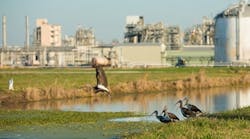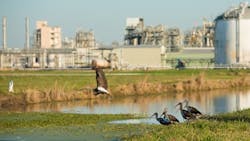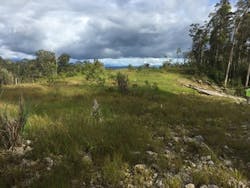Chemical makers worldwide are turning to local environmental organizations to help them improve their operations and sustainability — and profits. Among others, Dow, ExxonMobil and Chemours have benefited from such partnerships.
Dow’s approach to environmental management is a strategy called Valuing Nature, one of seven 2025 sustainability goals designed to propel the company toward solving some of the most significant challenges society faces. The strategy emphasizes projects that are good for the company and better for the ecosystem. It aims to save $1 billion in net present value with such projects by 2025.
Thomas Polzin, program manager for nature and ecosystem services at Dow, Bristol, Pa., leads the Valuing Nature group, which has expertise in biomimicry, civil infrastructure, environmental technology, engineering and remediation. “We define ‘nature’ as four pillars: clean air, clean water, healthy soil and healthy ecosystems. We had to define the word to really focus our message and effort. We are really focused on the water pillar currently and Dow, like other large manufacturing operations, is a huge water user,” he notes (Figure 1).
Since 2011, Dow has been working to develop projects with The Nature Conservancy (TNC), Arlington, Va. Today, the projects are in three different categories: engineering natural technologies, process improvement and surplus land management.
Dow’s Hot Springs, Ark.,, restoration work provides a good example of engineering natural technologies. The location, a former Union Carbide mining site, is prone to very heavy periods of rain that create temporary channels and creeks. This rain washes out old mine tailings, which makes the water acidic and rich in zinc.
“The tradition for this sort of problem is to build a wastewater treatment plant. But now we have a regime of limestone-lined creeks to manage the water flow. The limestone neutralizes the acidity from the tailings and the channels themselves wind which creates pools and oxygenates the water. The zinc is grounded by the vegetation that has grown in these wetlands. The quality of the water flowing out of the channels into the river downstream is now so good that fish are beginning to repopulate it, after many years away,” Polzin explains. As a result of the effect of this passive treatment strategy, there is an opportunity to repurpose the land and turn it into parkland for the local community. “We’ve learned a lot about wetlands on this project — not least that nature knows what it’s doing,” he notes.
Process improvement is a key part of the Valuing Nature strategy. Dow already has achieved some notable successes. For example, at its Tarragona facility in Spain, the company’s own reverse osmosis, fouling-resistant membrane and ion exchange resin technology purify city wastewater for steam and various process streams use. At the same time, the site has reduced by up to 49% the volume of wastewater generated by its cooling towers due to the higher quality of the reused water.
Managing surplus land is the third important piece of the company’s strategy. “The Dow riverside wetlands project, across the river from downtown Midland, Mich., is a project that was executed to provide key ecosystem services for the area. This is especially evident during flood events, where the riverside wetlands will ‘absorb’ floodwaters from the river, while Dow’s Michigan manufacturing operations — which are located in the area — and downtown Midland do not,” Polzin stresses.
Dow is considering other opportunities, too, including a large tract of land in Fort Saskatchewan, Alberta, Canada. The company may return that land to natural habitat and graze it with sheep, instead of landscaping and mowing. It recently has adopted such an approach at its Terneuzen site in the Netherlands.
The company very much believes in the “nature has no fence lines” approach, and that it always should look for opportunities beyond its own sites, says Polzin. At Freeport, Texas, Dow actively is talking with a customer on soil-related projects. “This customer has been very enthusiastic and they actually approached Dow first as they were also working with TNC. We are also working with them in the state of Sao Paolo in Brazil to coordinate efforts in the Latin American region. Here, we are also working with key suppliers and customers to see if we can drive further value,” he notes.
To further illustrate how Dow’s strategy works, his Valuing Nature group, together with a team from TNC, held a half-day workshop at Dow Fort Saskatchewan in June to identify value and mindset shifts needed to help meet the 2025 goal. This session identified a number of opportunities whose merits currently are being considered.
Progress In The Pacific
ExxonMobil Papua New Guinea (EMPNG) has produced more than 27 million metric tons of liquefied natural gas (LNG) since production began in 2014. The company operates PNG LNG JV, a $19-billion project that includes gas production and processing units, liquefaction and storage facilities, and 700 km of linking pipelines across the country.
Since the start of work in the country, EMPNG has worked closely with the Papua New Guinea (PNG) Conservation and Environment Protection Authority (CEPA). Together, they have developed an offset program to improve the sustainability of operations. This has five components: protected area planning; support for the national biodiversity strategy; building conservation capacity; enhancing existing protected areas; and establishing new protected areas.
So, for example, EMPNG supports CEPA by developing a protected area system plan for the Kikori river basin. EMPNG engaged the PNG Wildlife Conservation Society to lead this initiative because of its expertise in regional conservation planning.
Another project focuses on general maintenance and repair work caused by ground erosion and sediments along the route of a buried pipeline (Figure 2). Here, efforts include identifying and sealing ground surface tension cracks, clearing vegetation and silt from berms and drainage outlets, reinforcing drainage outlets, installing further erosion controls, constructing additional berms and re-contouring existing berms. In addition, monthly monitoring is taking place along a greenfield section in preparation for new pipeline installations in 2019.
CEPA also works with the company on ecological management issues, including checking the state of mangroves and other vegetation at all worksites. This monitoring shows that mangroves along the pipeline route and access points — and at the LNG plant site — are continuing to grow through natural regeneration following the end of construction.
EMPNG also is addressing the problems caused by an invasive species, the cane toad, that competes for food with some native species and secretes a toxin that can be harmful to humans and animals. It engaged a third-party contractor to launch a control program at the Hides waste management facility during 2017.
Over 120 EMPNG staff underwent invasive species education last year. Moreover, in concert with ecosystem management specialist Biotropica Australia, Tarzali, Australia, and PNG’s National Agriculture Quarantine and Inspection Authority (NAQIA), the company has just published “Exotic Plants of the Kikori River Basin.”
“Papua New Guinea is becoming increasingly concerned about the occurrence, spread and economic impact of weeds on the region’s food and cash crops, as well as the significant threat weeds pose to native forests in many parts of the country. As well as the work being conducted by Papua New Guinean authorities to reduce the occurrence of weeds, EMPNG has weed management programs in place as part of our environmental management plan,” says Laura Ann Dresser, general manager, environment and regulatory affairs.
Independent environmental and social consultant company Rina Consulting, Genoa, Italy, audits all the company’s activities, including its ecological and biodiversity management. The latest report, just published, notes that EMPNG’s biodiversity offset strategy continues to strengthen.
Certified Performance
The Wildlife Habitat Council (WHC), Silver Spring, Md., promotes habitat conservation and management on corporate lands through partnerships and education. One of the organization’s key focuses is on remediation. The WHC has identified five phases for successful remediation: investigation; remedy selection and permitting; implementation; maintenance and monitoring; and restoration and site reuse. The group awards conservation certification to companies that are successful in one or more of these phases.
One site that has achieved such certification is run by Chemours in Newport, Del. Formerly a pigment manufacturing operation that utilized a pump-and-treat system to address groundwater contamination, today the site is 92 acres of freshwater wetland, deciduous forest and meadows.
With the site requiring long-term maintenance during its remediation process, Chemours decided to transform the property into a wildlife habitat and engage company staff based out of a nearby office complex in habitat management activities. The site is fenced, with special permission needed for access. So, the team created conservation projects manageable by a team of employees who visit several times per year, with additional assistance from partners such as the Delaware Department of Agriculture and Monarch Watch, a butterfly conservation group, in Wilmington, Del.
Habitat projects include pollinator meadows, tree swallow nest boxes and biological control of an invasive plant, the purple loosestrife, using Galerucella beetles. The Chemours team has integrated these activities into company operations, helping to minimize the effort required to maintain and monitor the projects. For example, contractors and staff visiting the site to perform scheduled maintenance and monitoring also perform habitat maintenance.
The company also has developed wildlife habitats at its Washington Works in West Virginia and its Chambers Works in New Jersey. The Chambers Works additionally has gained WHC certification for its engagement with volunteers and school-age students.
In addition, the WHC has certified the site of Chevron’s former refinery in Cincinnati, Ohio. Covering approximately 500 acres, the land has gone through a remediation process and now provides a vibrant ecosystem for wildlife.
One of the key successes of that program is its innovative educational program dedicated to training the next generation of environmental scientists through research related to the site’s habitat and species projects. Graduate students at the University of Cincinnati, summer interns and new employee hires conduct research and work on restoration and enhancement projects in their own areas of expertise. Over the years, these have included surveys on game, rodents and insects.
One current project is using automated acoustic monitoring devices (AMDs) to record ambient noise in habitats made by animals such as frogs and birds. Doctoral students are developing special software to enable identifying each species present by the noises it makes. If using AMDs proves as effective as traditional survey strategies, Chevron will roll out the devices to other sites.
The inaugural WHC project award for wetlands and water bodies, bestowed in 2016, highlights the complex challenges posed by remediation and time needed to achieve success. The Nocatee site in southern Florida of CSX Transportation received the honor for floodplain restoration, along with its work on other on-site wetlands.
Starting in the late 1800s, the Nocatee site operated as an oil storage and wood-treating facility, leading to contamination of much of the soil with many different chemicals, especially creosote. With U.S. Environmental Protection Agency approval, CSX developed a remediation plan. This began in 2014 with the excavation and removal of affected soil — an effort that took a whole year.
On-site consolidation and containment of affected soils and the use of on-site borrow pits (sources of soil) for backfill reduced the carbon footprint of the site restoration. Trees removed during land clearing were reused as habitat and mulch throughout the site. Additionally, systems designed for in-situ treatment were put into place to treat affected soil and groundwater.
During this process, 37 protected gopher tortoises were found; a CSX team of employee volunteers worked with the Florida Fish and Wildlife Conservation Commission to relocate all of them.
Much of the habitat program at Nocatee focuses on the site’s several wetlands, which include a 35-acre parcel of the Peace river floodplain. For restoration of the floodplain, the team planted native wetland plant species, both to prevent erosion and to create wildlife habitat. Since the floodplain’s restoration, the team has observed hydric soil conditions (i.e., soil seasonally saturated by water) and a survival rate of more than 85% of the established native plants.
The current crop of projects underway at the site are primarily focused on developing native grasslands to provide habitat for pollinators.





